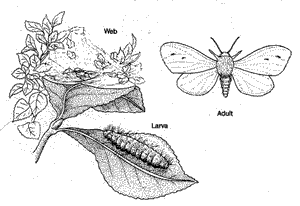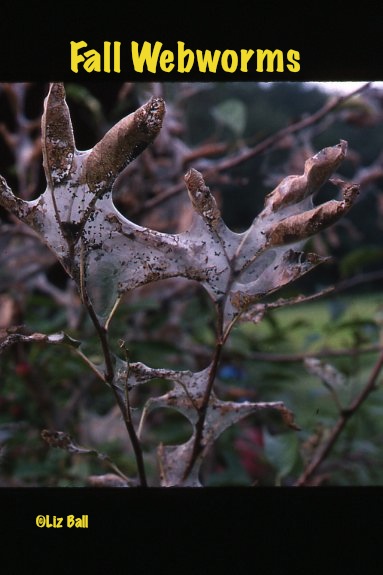Dealing With Fall Webworm
 |
The fall webworm is a widespread pest of shade trees (over 85 species) and numerous home landscape shrubs. Vulnerable trees include Black walnut, willow, American elm, some maples, crab apple and other fruit trees, hickory, sweetgum, and sycamore. The preferred hosts in the South are persimmon, pecan, and sourwood. In the west, alder, willow, cottonwood and fruit trees are commonly attacked.
 |
| Jeff Ball ©: |
| In Quaking Aspen |
The fall webworm is often mistaken for the tent caterpillar because both spin conspicuous gray, somewhat transparent, silken webs. The fall webworms construct their webs over the ends of branches and are present in late summer/early fall. Tent caterpillars on the other hand make their webs at tree crotches and are spring pests.
So if it is fall and you have tents in your trees you have fall webworm. If it is spring you have Tent caterpillars.
Though the fall webworm webs are very unsightly, damage to most trees in the north is considered to be insignificant. In the southern part of the country however, you can get two generations of fall webworm and damage can be severe. This pest is native to North America and is common from Canada into Mexico.
 Symptoms of Fall Webworm
Symptoms of Fall WebwormYou will start seeing the webs in late summer or early fall in north, earlier in the south. The large fall webworm webs are conspicuous, expanding to 2 to 3 feet in length as the caterpillars get larger. This is because the caterpillars stay inside the web to eat, so they must keep expanding the tent. So inside the webbing, fall webworm caterpillars eat and skeletonize leaves. Webs are more numerous in open locations such as along roadsides or on trees in home landscapes. These webs are unsightly because they include dark fecal droppings, growing caterpillars, and dying vegetation.
Webworms may defoliate whole sections of shrubs such as boxwoods. Trees are less affected, but they may stress trees. Fall webworms seldom kill host trees since they attack in late season when damage is less of a problem to the host. They are usually less numerous than tent caterpillars.
Fall Webworm Solutions With No Insecticides
Natural Predators - Fall webworms are usually held in check by songbirds, yellow jackets, wasps, and rodents like mice eat the caterpillars and pupae. Ants, spiders and a host of parasitic wasps attack eggs before they hatch.
Remove The Webs - You can easily remove the webs when they occur in trees around the home. Because burning the web may leave scorched foliage and plant parts; this technique is not recommended. A strong stream of water from a high pressure washer or simply poking and tearing the web apart once or twice is usually all that is needed. Webs can be pruned out provided it doesn't leave the host unsightly.
Fall Webworm Solutions Using Insecticides
Natural Insecticides - Insecticides are seldom necessary for fall webworm, especially in trees, and should be considered only if the infestation is heavy. The insecticide Bacillus thuriengensis (BT) can be used when the caterpillars are small, but it will not provide satisfactory control once the webs are large and conspicuous. Try to thoroughly cover the leaves right next to existing nests. Then as these leaves are incorporated into the nest and eaten, the Bt will be ingested. For treating large trees or for larger areas, consider professional tree care specialists, who are trained and licensed to use other insecticides not available to the homeowner.

